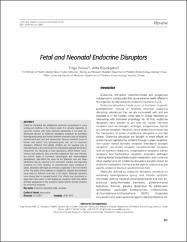Fetal and neonatal endocrine disruptors.
Künye
Unüvar T, Büyükgebiz A. Fetal and neonatal endocrine disruptors. J Clin Res Pediatr Endocrinol. 2012; 4(2): 51-60. doi: 10.4274/jcrpe.569.Özet
Endocrine disruptors are substances commonly encountered in every setting and condition in the modern world. It is virtually impossible to avoid the contact with these chemical compounds in our daily life. Molecules defined as endocrine disruptors constitute an extremely heterogeneous group and include synthetic chemicals used as industrial solvents/lubricants and their by-products. Natural chemicals found in human and animal food (phytoestrogens) also act as endocrine disruptors. Different from adults, children are not exposed only to chemical toxins in the environment but may also be exposed during their intrauterine life. Hundreds of toxic substances, which include neuro-immune and endocrine toxic chemical components that may influence the critical steps of hormonal, neurological and immunological development, may affect the fetus via the placental cord and these substances may be excreted in the meconium. Children and especially newborns are more sensitive to environmental toxins compared to adults. Metabolic pathways are immature, especially in the first months of life. The ability of the newborn to metabolize, detoxify and eliminate many toxins is different from that of the adults. Although exposures occur during fetal or neonatal period, their effects may sometimes be observed in later years. Further studies are needed to clarify the effects of these substances on the endocrine system and to provide evidence for preventive measures.


















